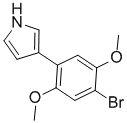fastandbulbous
Bluelight Crew
- Joined
- Jul 29, 2004
- Messages
- 21,304
adding the phenyl grignard, then dehydrating the tertiary alcohol gives both possible alkenes, ie the 2-3 alkene and the 3-4 alkene
As tropane is symmetrical, the 2,3-alkene is identical to the 3,4-alkene (if it wasn't symmetrical than tropine would be optically active & it isn't)
Anybody have any ideas on these?
Only 5a & 5b have any possibilities. Alpha vinyl PEA's are pretty much untested territiry, but alpha vinyl tryptamine might just have unexpected activity as it's capable of positioning the double bond in the same manner as the double bond of the C ring of LSD.
Aromatic amines are generally known to be carcinogens & 2 would be unstable (besides epoxide rings are DNA alkylators and as such, well didgy)


